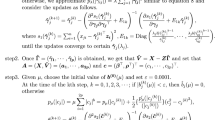Abstract
This paper studies variable selection problem in structural equation of a two-stage least squares (2SLS) model in presence of endogeneity which is commonly encountered in empirical economic studies. Model uncertainty and variable selection in the structural equation is an important issue as described in Andrews and Lu (2001) and Caner (2009). The authors propose an adaptive Lasso 2SLS estimator for linear structural equation with endogeneity and show that it enjoys the oracle properties, i.e., the consistency in both estimation and model selection. In Monte Carlo simulations, the authors demonstrate that the proposed estimator has smaller bias and MSE compared with the bridge-type GMM estimator (Caner, 2009). In a case study, the authors revisit the classic returns to education problem (Angrist and Krueger, 1991) using the China Population census data. The authors find that the education level not only has strong effects on income but also shows heterogeneity in different age cohorts.
Similar content being viewed by others
References
Heckman J J, Sample selection bias as a specification error, Econometrica, 1979, 47: 153–161.
Lin L, Cui X, and Zhu L, An adaptive two-stage estimation method for additive models, Scandinavian Journal of Statistics, 2009, 36: 248–269.
Angrist J D and Krueger A B, Does compulsory school attendance affect schooling and earnings?, Quarterly Journal of Economics, 1991, 106: 979–1014.
Darolles S, Fan Y, Florens J P, et al., Nonparametric instrumental regression, Econometrica, 2011, 79: 1541–1565.
Newey W, Efficient instrumental variables estimation of nonlinear models, Econometrica, 1990, 58: 809–837.
Fan Q and Zhong W, Nonparametric additive instrumental variable estimator: A group shrinkage estimation perspective, Journal of Business & Economic Statistics, 2016, DOI: 10.1080/07350015.2016.1180991.
Belloni A, Chen D, Chernozhukov, et al., Sparse models and methods for optimal instruments with an application to eminent domain, Econometrica, 2012, 80: 2369–2429.
Andrews D W K and Lu B, Consistent model and moment selection procedures for GMM estimation with application to dynamic panel data models, Journal of Econometrics, 2001, 101: 123–165.
Tibshirani R, Regression shrinkage and selection via the Lasso, Journal of the Royal Statistical Society, 1996, 58: 267–288.
Fan J and Li R, Variable selection via nonconcave penalized likelihood and its oracle properties, Journal of the American Statistical Association, 2001, 96: 1348–1360.
Zou H, The adaptive Lasso and its oracle properties, Journal of the American Statistical Association, 2006, 101: 1418–1429.
Breiman L, Better subset regression using the nonnegative garotte, Technometrics, 1996, 37: 373–384.
Caner M, Lasso-type GMM estimator, Econometric Theory, 2009, 25: 270–290.
Liao Z, Adaptive GMM shrinkage estimation with consistent moment selection, Econometric Theory, 2013, 29: 1–48.
Efron B, Hastie T, Johnston I, et al., Least angle regression, The Annals of Statistics, 2004, 32: 407–499.
Schwarz G, Estimating the dimension of a model, Annals of Statistics, 1978, 6: 461–464.
Wang H, Li R, and Tsai C, Tuning parameter selectors for the smoothly clipped absolute deviation method, Biometrika, 2007, 94: 553–568.
Caner M and Fan Q, Hybrid generalized empirical likelihood estimators: Instrument selection with adaptive lasso, Journal of Econometrics, 2015, 187: 256–274.
Knight K and Fu W, Asymptotics for Lasso type estimators, The Annals of Statistics, 2000, 28: 1356–1378.
Wang H, Li B, and Leng C, Shrinkage tuning parameter selection with a diverging number of parameters, Journal of the Royal Statistical Society Series B, 2009, 71: 671–683.
Imbens G W and Rosenbaum P R, Robust, accurate confidence intervals with a weak instrument: Quarter of birth and education, Journal of Royal Statistics Society: Series A, 2005, 168: 109–126.
Buckles K S and Hungerman D M, Season of birth and later outcomes: Old questions, new answers, Review of Economics and Statistics, 2013, 95: 711–724.
Wu Y, Searching for the Archimedes’ lever: Is quarter-of-birth really a weak instrumental variable?, China Economic Quarterly, 2010, 2: 661–686.
Shi Q and Li W, A total-education-years (TEYs) approach in measuring human capital: Based on the 2010 population census, Chinese Journal of Population Science, 2014, 160: 95–128.
Andersen P K and Gill R D, Cox’s regression model for counting processes: A large sample study, Annals of Statistics, 1982, 10: 1100–1120.
Pollard D, Asymptotics for least absolute deviation regression estimators, Econometric Theory, 1991, 7: 186–199.
Author information
Authors and Affiliations
Corresponding author
Additional information
Fan’s research was supported by the National Natural Science Foundation of China under Grant No. 71671149, the Fundamental Research Funds for the Central Universities under Grant No. 20720171042, and the Natural Science Foundation of Fujian Province of China under Grant No. 2016J01340; Zhong’s research was supported by the National Natural Science Foundation of China under Grant Nos. 11671334, 11301435, and 11401497.
This paper was recommended for publication by Editor SUN Liuquan.
Rights and permissions
About this article
Cite this article
Fan, Q., Zhong, W. Variable Selection for Structural Equation with Endogeneity. J Syst Sci Complex 31, 787–803 (2018). https://doi.org/10.1007/s11424-017-6195-4
Received:
Revised:
Published:
Issue Date:
DOI: https://doi.org/10.1007/s11424-017-6195-4




